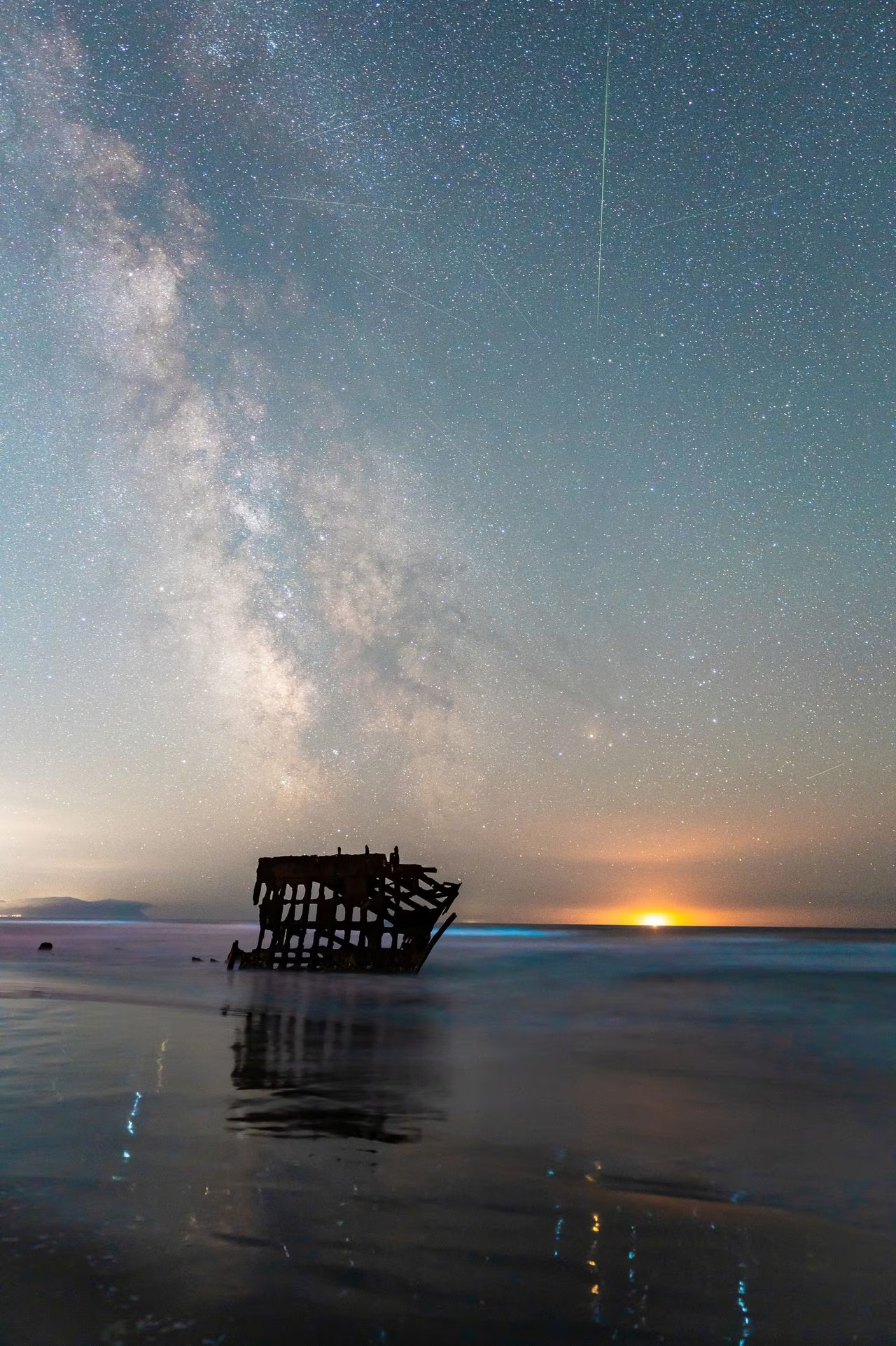
The night sky has long held an allure that captivates and enchants observers, offering a canvas for celestial events that inspire wonder and reflection. On the evening of August 12, 2023, Portland-based photographer Jay Shah embarked on a visual odyssey to capture the Perseid meteor shower at its peak, weaving together elements of nature's beauty that spanned from the heavens to the deep sea. Shah's extraordinary images, taken at the iconic Peter Iredale Shipwreck within Fort Stevens State Park along the northwest Oregon coast, reveal a breathtaking tapestry of shooting stars, the Milky Way's splendor, ethereal bioluminescence, and a ship gracefully silhouetted against the horizon, reminiscent of a sun setting on the waters.
Shooting stars streaking across the firmament, like fleeting wishes trailing through the cosmos, are an iconic hallmark of meteor showers. Shah's lens deftly captured these luminous travelers, their incandescent trails painting a celestial masterpiece against the obsidian backdrop of the night sky. The Perseid meteor shower, an annual event caused by the Earth's passage through debris left behind by the Swift-Tuttle comet, transforms the heavens into a theater of cosmic brilliance, offering a celestial spectacle that has inspired wonder for generations.
In a harmonious juxtaposition, the Milky Way's resplendent spiral arcs across the firmament, a celestial river of stars and dust that has long fueled human imagination and exploration. Shah's lens unravels this cosmic tapestry, revealing the intricate dance of stars that grace the canvas of the night sky, a testament to the universe's boundless grandeur.
Yet, Shah's lens transcends the confines of the sky, delving into the depths of the ocean's mysteries. Bioluminescence, nature's own luminescent artistry, ignites the waters around the shipwreck like a symphony of ghostly fireflies. The ethereal glow lends an otherworldly aura to the scene, casting an enchanting spell that blurs the boundaries between the terrestrial and the cosmic.
Central to Shah's composition is the haunting silhouette of the Peter Iredale Shipwreck, an iconic relic of maritime history. The ship's timeworn frame stands as a testament to the unforgiving power of the sea, while its juxtaposition against the cosmic tableau conjures a sense of timeless beauty and transience. The ship's outline against the horizon evokes the hues of a setting sun, as if the vessel itself were a celestial traveler on an eternal voyage.
Shah's artistic technique further enhances the emotive impact of his imagery. Employing single long exposure shots, he skillfully captures the essence of each element, from the ephemeral streaks of meteorites to the tranquil luminescence of the bioluminescent waters. Through his lens, the sublime dance of nature unfolds in a single frame, inviting viewers to lose themselves in the majesty of the universe.
It is worth noting that Shah's photographic journey also uncovers the resilience of the night sky against light pollution. The images stand as a testament to the importance of preserving and cherishing our dark skies, where celestial wonders can be witnessed in their full splendor, unimpeded by urban illumination.
As the Perseid meteor shower continues to grace the heavens, Shah's photographic masterpiece serves as a reminder of the sublime harmony that exists between the cosmos and Earth's terrestrial beauty. His lens captures not just a meteorological phenomenon, but an artistic convergence that celebrates the cosmic dance, the ocean's mysteries, and the legacy of human exploration, all illuminated by the shimmering tapestry of the Perseid meteor shower.
Image Credit: Jay Shah
Taken 10:39pm, August 12, 2023. Camera: Sony Alpha 7 IV. Lens: FE 24mm F1.4. Exposure: 15 seconds. ISO: 3200 Aperture: f/1.6
Image Credit: Jay Shah
Taken 10:27pm, August 12, 2023. Camera: Sony Alpha 7 IV. Lens: FE 24mm F1.4. Exposure: 20 seconds. ISO: 3200 Aperture: f/1.6
Chasing the Darkness: Unveiling Oregon's Hidden Stargazing Gems
As the night sky beckons with its cosmic wonders, enthusiasts and stargazers often seek refuge in the embrace of darkness to fully immerse themselves in the celestial symphony. Oregon, known for its natural beauty and pristine landscapes, offers a haven for those yearning to escape the pervasive glow of urban lights.
The interactive map below showcases the extent of light pollution caused by human activity, revealing pockets of pristine darkness amidst the illuminated canvas. These secluded locations, far from the city's luminous embrace, provide the ideal vantage points for observing meteor showers, the Milky Way, and other celestial marvels.
Embracing the beauty of the Oregon night sky requires a journey to these sanctuaries of darkness, where the celestial ballet performs unhindered by artificial illumination. From Fort Stevens State Park to Crater Lake National Park, the darkest corners of Oregon promise an unobstructed view of the universe's wonders, inviting observers to cast their gaze upward and explore the infinite mysteries that await.
Image Credit: Mark Graves | The Oregonian/OregonLive
Leave a Reply